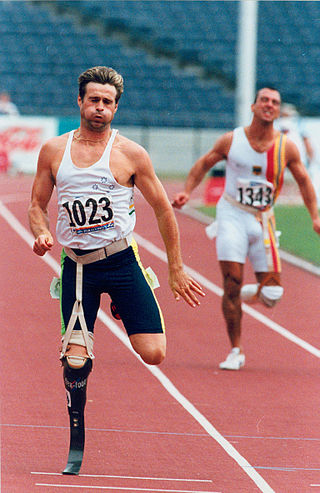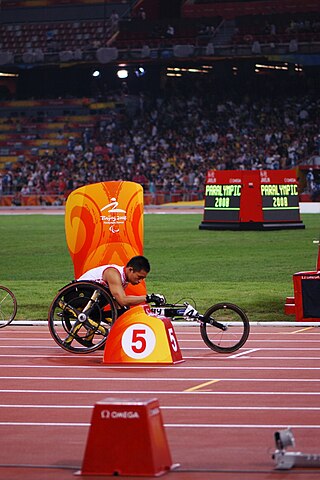S10, SB9, SM10 are para-swimming classifications used for categorizing swimmers based on their level of disability. Swimmers in this class tend to have minimal weakness affecting their legs, missing feet, a missing leg below the knee or problems with their hips. This class includes a number of different disabilities including people with amputations and cerebral palsy. The classification is governed by the International Paralympic Committee, and competes at the Paralympic Games.
S5, SB4, SM5 are para-swimming classifications used for categorizing swimmers based on their level of disability. The class includes people with a moderate level of disability, and includes people with full use of their arms and hands, but limited to no use of their trunk and legs. It also includes people with coordination problems. A variety of disabilities are represented by this class including people with cerebral palsy. The class competes at the Paralympic Games.
S3, SB2, SM3 are para-swimming classifications used for categorising swimmers based on their level of disability. People in this class have some arm and hand function, but no use of their trunk and legs. They have severe disabilities in all their limbs. Swimmers in this class have a variety of different disabilities including quadriplegia from spinal cord injury, cerebral palsy and multiple amputations.
T33 and CP3 are disability sport classification for disability athletics. The class competes using a wheelchair. The classification is one of eight for people with cerebral palsy, and one of four for people with cerebral palsy who use a wheelchair. Athletes in this class have moderate quadriplegia, and difficulty with forward trunk movement. They also may have hypertonia, ataxia and athetosis.
T34 is a disability sport classification for disability athletics. The classification is one of eight specifically for athletes with cerebral palsy, and one of four for athletes with cerebral palsy who use a wheelchair. People in this class have hypertonia, ataxia and athetosis. This class includes people who have cerebral palsy, or who have had a stroke or traumatic brain injury.

T44 is a disability sport classification for disability athletics, applying to "Single below knee amputation or an athlete who can walk with moderately reduced function in one or both legs." It includes ISOD A4 and A9 classes.

T46 and F46 are disability sport classification for disability athletics. People in this class have a single below or above the elbow amputation. The amputee sports equivalent class is ISOD the A6 and A8 classes. People in this class can have injuries as a result of over use of their remaining upper limb. The classification process to be included in this class has four parts: a medical exam, observation during training, observation during competition and then being classified into this class.
T52 is disability sport classification for disability athletics. People in this class have good shoulder and upper body control, but lack fine motor skills in their arms and hands. They have no or limited trunk and leg function. The class includes people with a number of different types of disabilities including spinal cord injuries. Similar classifications are T51, T53 and T54.

T53 is disability sport classification for disability athletics. The class includes people with a number of different types of disabilities including spinal cord injuries. People in this class have full use of their arms but have no or limited trunk function. Similar classifications are T51, T52, and T54. People in this class have a functional upper limbs, but limited trunk usage and limited lower limb functionality. During classification, they both undergo a bench test of muscle strength and demonstrate their skills in athletics. People in this class include Tanni Grey-Thompson (GBR), Samantha Kinghorn (GBR), Angie Ballard (AUS) and Richard Colman (AUS).
ARW1 is a Paralympic archery classification. It is a sitting class. This class includes Les Autres sportspeople. People from this class compete in the sport at the Paralympic Games.
F57 is a disability sport classification for disability athletics for people who compete in field events from a seated position. This class is for people with limb deficiencies not covered by other classes. It includes people who are members of the ISOD A1 and A9 classes. Events open to people in this class include the shot put, discus and javelin.
F56 is a disability sport classification for disability athletics for people who compete in field events from a seated position. The seating field event class used to be known as lower 4, upper 5. Different disability groups compete in this class, including people with amputations and spinal cord injuries. Events that may be on the program for F56 competitors include the discus throw, shot put and javelin.
F55 is a disability sport classification for disability athletics for people who compete in field events from a seated position. Sportspeople in this class have full arm function, partial trunk function and no lower limb function. Different disability groups compete in this class, including people with spinal cord injuries. The classification was previously known as lower 3, upper 4.
LA1 is a Les Autres sport classification is an wheelchair sport classification for a sportsperson with a disability that impacts their locomotor function. People in this class have severe locomotor issues with all four limbs as a result of loss of muscle strength or spasticity. This also impacts their dominant throwing arm. They also have poor sitting balance.
LA2 is a Les Autres sport classification is an wheelchair sport classification for a sportsperson with a disability that impacts their locomotor function. People in this class have severe locomotor issues with all four limbs as a result of loss of muscle strength or spasticity to a lesser degree than LAF1 or have severe locomotor issues in three of their limbs. They have moderate sitting balance, but good sitting balance while throwing.
LA3 is a Les Autres sport classification is a wheelchair sport classification for a sportsperson with a disability that impacts their locomotor function. People in this class have normal trunk function, good sitting balance, and functional upper limbs. They have limited use of their lower limbs.
LA4 is a Les Autres sport classification is an ambulatory sport classification for a sportsperson with a disability that impacts their locomotor function. People in this class may or may not uses crutches and/or braces on a daily basis. They have some issues with balance and reduced function in their upper limbs.
LA5 is a Les Autres sport classification is an ambulatory sport classification for a sportsperson with a disability that impacts their locomotor function. People in this class have normal upper limb functionality, but have problems with balance or use of their lower limbs. Generally, limb problems are confined to one limb.
LA6 is a Les Autres sport classification is an ambulatory sport classification for a sportsperson with a disability that impacts their locomotor function. People in this class have a minimal locomotor disability that tends to impact one of their upper limbs or knees. The class includes people with arthritis and osteoporosis, or ankylosis of the knee.
F8, also SP8, is a standing wheelchair sport classification open to people with spinal cord injuries, with inclusion based on a functional classification on a points system for lower limb functionality. Sportspeople in this class need to have less than 70 points. The class has largely been used in Australia and the United States. F8 has largely been eliminated because of a perceived lack of need internationally for a standing wheelchair class. Sports this class participates in include athletics, swimming and wheelchair basketball. In athletics, participation is mostly in field events.





